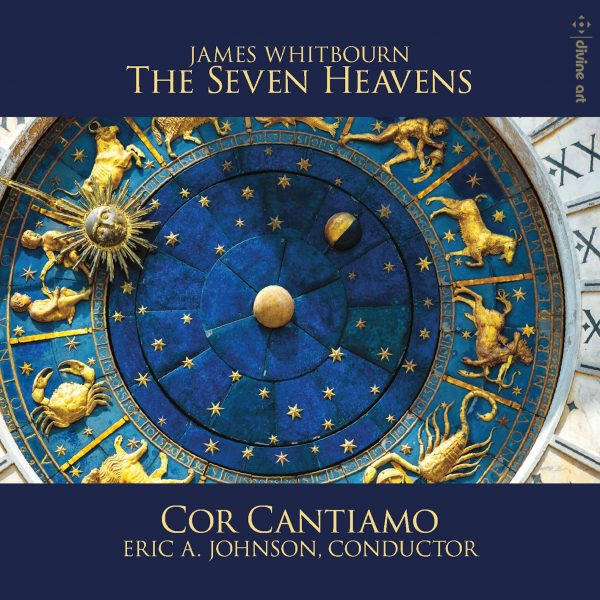Crescendo (Belgium)
Writer, historian, scholar of religions, professor at Oxford and Cambridge, it was Clive Staples Lewis (1898-1963) who inspired The Seven Heavens: this cantata establishes correspondences between the personal trajectory of the British man of letters and seven stars which founded the week in ancient mythology: Moon, Mars, Mercury, Jupiter, Venus, Saturn, Sun. The moments of its existence were divided by the academic Michael Ward into themes referring to these divinities and their iconic character (like Gustav Holst in his Planets). This provides a series of biographical sequences, the text of which must be read (or known) by the listener, behind the songs. When we know that Lewis, a great medievalist, was interested in cosmology which permeated some of his fictions (Chronicles of Narnia), we can guess the network of intersecting meanings that fueled the music of James Whitbourn.
We also think of Rachmaninoff’s Bells, whose structure leads us from the cradle to the grave. The Seven Heavens was first conceived for a large orchestra, honoring a commission from the Belfast Philharmonic (the birthplace of Lewis) to close the 2014-2015 season, then adapted for a small instrumental force accompanying the choir, at the request of Eric Johnson. The first performance of this chamber version took place in November 2016 at Northern Illinois University by the ensemble Cor Cantiamo we hear here. The lyrics come from the Orphic Hymns, Shakespeare, Thomas Lodge, Shelley… Sound allusions (sirens of ships in Belfast Lough call in The Moon, Magdalen College clock is heard in Mars, and other places Lewis frequented…) also run through the overall score, which is constructed according to the cycle of fifths. From one piece to another, the language surprises with its variety, even if it remains suggestive, accessible, consonant, generous. James Whitbourn knows how to communicate. We will not detail here this subtle work of writing, explained in the booklet. However, let’s mention a few steps and effects.
Piano, triangle, solo violin moisten the tender evocation of the young years. Emotion grips Mars as well, though this anguished episode is otherwise streaked with rumors of war (recalling the author serving as a lieutenant in the Somerset Light Infantry). Mercury, the ferryman, the messenger, illustrates the encounter with J.R.R. Tolkien who influenced the conversion to Christianity, at a time when Lewis abandoned poetry for prose and an academic career. The Jovian star, with which Lewis readily associated himself, radiates a debonair joie de vivre: the libretto does not mention it, but we can detect the canon melody of the medieval round Sumer is icumen in, within a flowery and springtime spirit. Emaciated as much as enamored, Venus delves into the union with New York writer Joy Davidman, who died prematurely of cancer (this relationship was the subject of the 1993 film Shadowlands, starring Anthony Hopkins and Debra Winger). The next installment, Saturn, introduced in dark deep voices, prolongs this mourning, and depicts Lewis’s own decline, whose epitaph bears a phrase from King Lear: “Men must endure their going hence”. But this portrait in music does not stop at this fateful vision and triumph over a hope of resurrection, following the aspirations that Lewis had developed in his Letters to Malcolm. This radiant apotheosis quotes the motto of the University of Oxford (Dominus illuminatio mea) and concludes with a reminder of the ritornello associated with Jupiter.
The program continues with other recent creations. Ada (2015) is a portrait of Ada Lovelace (daughter of Lord Byron) commissioned by one of her descendants, the Fifth Earl of Lytton. The mathematician owned a Stradivarius, which is why the violin dominates instrumentation. James Whitbourn used her first name as a melodic imprint (A-D-A in English terminology) which he inserts thirty-six times, one for each year of the young woman’s life. The text is borrowed from his famous father’s Childe Harold’s Pilgrimage.
Eternal Rest was originally written for orchestra on the occasion of the Queen Mother Elizabeth’s funeral (2002), then reduced to a refined antiphon with organ to the lyrics of the Requiem. We hear here a third version, specially written for this recording, colored by a panel of instruments. The two Canticles for Mary and Simeon were commissioned by the RSCM Millenium Youth Choir for their services at York Minster. The composer immersed himself in the history and meaning of these biblical figures, which he situates in their Judaic perspective with a harmonic, prosodic and melodic outline clearly derived from Jewish music. Viola and organ reinforce the lament. Magnificent !
You may already be familiar with Annelies (from the Diary of Anne Frank), one of James Whitbourn’s most performed works, cataloged in the repertoire of leading UK university choral ensembles. His discography has a few CDs. This one, remarkably interpreted, brings together pages representative of his homogeneous, communicative and direct style. This uninhibited eloquence needs no other advocate than his warm, spontaneous, fervent art, which speaks to the heart and will conquer you as such.
@divineartrecordingsgroup
A First Inversion Company
Registered Office:
176-178 Pontefract Road, Cudworth, Barnsley S72 8BE
+44 1226 596703
Fort Worth, TX 76110
+1.682.233.4978












![Listen to the full suite of Marcel Dupré’s Variations Sur un Noël, Op. 20 from Alexander Ffinch’s #Expectations release today! listn.fm/expectations [in bio]](https://scontent-dfw5-1.cdninstagram.com/v/t51.71878-15/588904367_2327488161082898_8709236950834211856_n.jpg?stp=dst-jpg_e35_tt6&_nc_cat=105&ccb=7-5&_nc_sid=18de74&efg=eyJlZmdfdGFnIjoiQ0xJUFMuYmVzdF9pbWFnZV91cmxnZW4uQzMifQ%3D%3D&_nc_ohc=BGoHgV_YYfIQ7kNvwHaEWWD&_nc_oc=Adnavy1XXPsySG9ucjtfudLjjHIdSeRMyt7Emd3nd1e5rZg4Zrj1WDqMfjt9iXen-Sd_Yp87jwT1h-Cr1RI5Hpaj&_nc_zt=23&_nc_ht=scontent-dfw5-1.cdninstagram.com&edm=ANo9K5cEAAAA&_nc_gid=faSDzKpa_l8k_GK20EeABw&oh=00_AfoeZjo3G-beZVQ8ekaU39SI7hhT3CpjkzQpbWib3e6AgA&oe=695EA3AA)